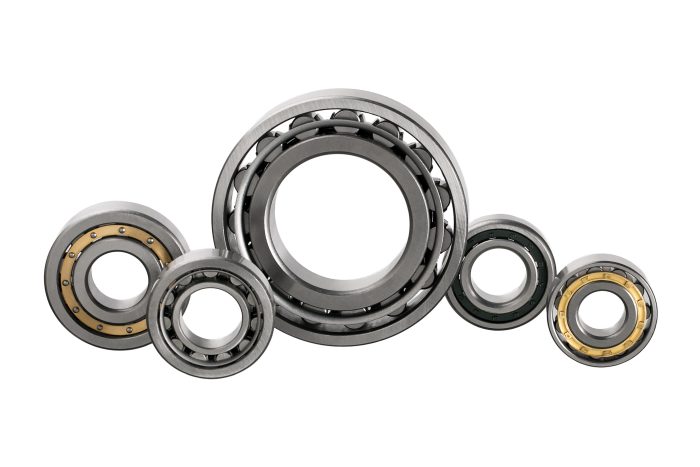| Subject | Symbol | Description |
|---|---|---|
| Radial internal clearance | C2 | Less than normal. |
| CN | Normal clearance. Is not indicated as a standard. | |
| C3 | Greater clearance than normal. | |
| C4 | Greater than C3. | |
| C5 | Greater than C4. | |
| Other technical modifications | K | Tapered bore. |
| Cage types | M | Brass cage ball guided. |
| S | Pressed steel cage. Riveted cage. Is not indicated as a standard. | |
| Speed ratings | V | Normal vibration level. Is not indicated as a standard. |
| V2 | Lower vibration level than normal. | |
| V3 | Lower vibration level than V2. | |
| V4 | Lower vibration level than V3. | |
| Tolerances | P0 | Normal tolerance level. Is not indicated as a standard. |
| P6 | Greater tolerance level than P0. | |
| P5 | Greater tolerance level than P6. |
Features
LBR cylindrical roller bearings are available in many designs, series and sizes. The majority are single row bearings with a cage. High-capacity bearings, single and double row full complement bearings (without a cage)
Due to the line contact in between rolling elements and raceways, LBR cylindrical roller bearings have higher radial load capacity and they are suited to high-speed applications due to their structure.
Together with a high strength cage design in pressed steel, the most cylindrical roller bearings consist of brass or polyamide and provides low noise, low heat generation and, for much more difficult applications could be provided in a variety of advanced special materials.
Our cylindrical bearings are equally suitable for heavy radial and impact loading.
Having a separable inner or outer ring, these bearings can be easily mounted and dismounted.
One-Row Cylindrical Bearings
N Style single row - N style cylindrical roller bearings have two machined flanges in the inner ring with no flanges on the outer ring, with rollers and cage on the inner ring. Much like the NU style, the N doesn't have thrust load carrying capability.
NU style single row - NU style cylindrical roller bearings have two machined flanges in the outer ring with no flanges in the inner ring.
NJ style single row - NJ style cylindrical roller bearings have two machined flanges in the outer ring plus a machined flange on one side in the inner ring. The roller and cage assembly is in the outer ring. The integral flange on the inner ring enables this bearing to handle an axial load.
NF style single row - NF style cylindrical roller bearings have two machined flanges in the inner ring and the other flange in the outer ring, with roller and cage on the inner ring. Much like the NJ bearing, these bearings possess some thrust load capability.
NUP style single row - NUP style cylindrical roller bearings are like the NJ style and come with a special ring called a thrust collar. Mounted on the non-flange side of the inner ring, the thrust collar allows the bearing to hold an axial load in both directions. The thrust collar extends out of your bearing on one side, therefore the dimensions across the inner ring is slightly higher than that of the outer ring.
NP (Also able to carry incidental thrust loads in both directions, and may be used with a type RN or RU to accommodate axial expansion and contraction. Two integral ribs on inner ring, one integral rib on outer ring.
Two-Row Cylindrical Bearings (NN)
Cylindrical roller bearings, in which either the inner or outer rings has two ribs and the other ring has one, are capable of taking some axial load in one direction Double-row cylindrical roller bearings have high radial rigidity and are used primarily for precision machine tools
Cages
Small and medium-sized single row cylindrical roller bearings are generally fitted with pressed sheet cages. Large-sized bearings are fitted with machined brass cages of normal design, i.e. cages of separable design guided on rolling elements M, on the outside surface MA or inner surface MB.
In case of heavy loads and high speeds, cages are made in one piece.
LOADS
Cylindrical roller bearings must be subjected to a given minimum load, so that a proper operation of these bearings can be guaranteed.
This is necessary especially as the bearings are operated at high speeds and the centrifugal forces produce additional friction in bearing due to the sliding between rollers and raceway.

